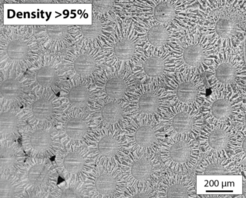Highlights 2013
Research news from the division Plasma Edge and Wall

Brittle material becomes pseudo ductile: Tungsten fibre reinforced Tungsten
Due to a unique property combination tungsten is a favoured candidate for the use in plasma facing components in a future fusion reactor. However its inherent brittleness and the subsequent lack of damage tolerance strongly restrict its application. In particular the poor resistance against operation embrittlement due to recrystallization or irradiation damage is up to now an unsolved problem.
A possible solution is the generation of structures which allow local energy dissipation and thus generate an enhanced fracture resistance and therefore toughness. This is called extrinsic, i.e. externally applied toughening or pseudo toughness. Examples for such mechanisms are fibre bridging, crack deflection or the ductile fibre deformation.
This idea is investigated and implemented within a research project in the division „Plasma Edge and Wall“. Here tungsten is reinforced by coated long fibres made of drawn tungsten wire. The toughening mechanisms have been identified and their stability against embrittlement was shown by means of high energy synchrotron tomographic experiments. In bending test on larger samples stable crack propagation and a doubling of the load bearing capability have been observed. Analytic calculations revealed the high potential of tungsten fibre reinforced tungsten. Compared to other tungsten materials the new composite features a real damage tolerance at room temperature as well as the possibility of local energy dissipation and therefore an increased toughness in the as produced and embrittled state.
With this work Johann Riesch graduated at the TU München with summa cum laude on November the 19th 2012.
